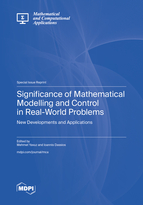Significance of Mathematical Modelling and Control in Real-World Problems: New Developments and Applications
A special issue of Mathematical and Computational Applications (ISSN 2297-8747).
Deadline for manuscript submissions: closed (31 December 2022) | Viewed by 31664
Special Issue Editors
2. Department of Mathematics, College of Engineering, Mathematics and Physical Sciences, University of Exeter, Cornwall TR10 9FE, UK
Interests: differential/difference equations; dynamical systems; modeling and stability analysis of biological systems; financial mathematics; fractional calculus; mathematical modeling; fluid dynamics; optimal control
Special Issues, Collections and Topics in MDPI journals
Interests: differential/difference equations; dynamical systems; modeling and stability analysis of electric power systems; mathematics of networks; fractional calculus; mathematical modeling (power systems, materials science, energy, macroeconomics, social media, etc.); optimization for the analysis of large-scale data sets; fluid mechanics; discrete calculus; Bayes control; e-learning
Special Issues, Collections and Topics in MDPI journals
Special Issue Information
Dear Colleagues,
Mathematical modeling and systems control arise in many research problems, ranging from physical and chemical processes to biomathematics and life science. Their theoretical description is closely connected with various areas of pure and applied mathematics including nonlinear modeling, integro-differential equations, nonlinear dynamics, pattern formation, non-Markovian processes, nonlinear and anomalous transport, time-delay equations and so on.
The aim of this Special Issue is to collect original and high-quality contributions related to the mathematical theory of such processes and phenomena including the dynamical models, applied and computational algorithms, controller design and mathematical methods regarded as new and prominent for understanding the problems that arise in natural phenomena.
This Special Issue will cover new perspectives of the recent theoretical developments in mathematical modeling and/or optimal control and their illustrative applications in biology, engineering, finance, and health sciences. It aims to highlight new techniques that can be applied to the real-life problems which are modeled and to introduce new constructed effective models for the accurate prediction of infectious diseases, financial crisis, etc., into the literature by adopting suitable controls/control strategies. Moreover, it aims to provide new analytical and numerical methods to propose appropriate solutions to the real-life problems of both integer and fractional order differential equations and to understand their complicated behaviors in nonlinear phenomena.
The Special Issue also proposes the latest developments in nonlinear dynamical modeling, optimization and solution strategies that can be applied to prominent problems in engineering and biological systems.
This Special Issue helps the reader learn new theories and new methods of nonlinear dynamical systems, modeling and controlling them. It will also help the reader find new solutions to complex engineering, biological, financial and life sciences problems. This Special Issue also provides readers with new insights for novel modeling and optimization processes and will underline the relation between theory and practice.
The topics of the Special Issue include, but are not limited to:
- Mathematical modeling in real-world phenomena;
- Optimal control strategies in biosystems;
- New analytical and numerical methods for fractional differential equations;
- Modeling of fractional order systems with and without nonsingular kernels;
- Deterministic and stochastic differential equations arising in science;
- Applications in bioengineering, biology, and health sciences;
- Applications in finance and economic sciences;
- Optimal control problems of fractional order;
- Modeling of diffusion, heat, mass, and momentum transfer (fluid dynamics);
- Biomechanical and biomedical applications of fractional calculus;
- Impulsive systems;
- Fuzzy differential equations and their applications.
Dr. Mehmet Yavuz
Dr. Ioannis Dassios
Guest Editors
Manuscript Submission Information
Manuscripts should be submitted online at www.mdpi.com by registering and logging in to this website. Once you are registered, click here to go to the submission form. Manuscripts can be submitted until the deadline. All submissions that pass pre-check are peer-reviewed. Accepted papers will be published continuously in the journal (as soon as accepted) and will be listed together on the special issue website. Research articles, review articles as well as short communications are invited. For planned papers, a title and short abstract (about 100 words) can be sent to the Editorial Office for announcement on this website.
Submitted manuscripts should not have been published previously, nor be under consideration for publication elsewhere (except conference proceedings papers). All manuscripts are thoroughly refereed through a single-blind peer-review process. A guide for authors and other relevant information for submission of manuscripts is available on the Instructions for Authors page. Mathematical and Computational Applications is an international peer-reviewed open access semimonthly journal published by MDPI.
Please visit the Instructions for Authors page before submitting a manuscript. The Article Processing Charge (APC) for publication in this open access journal is 1400 CHF (Swiss Francs). Submitted papers should be well formatted and use good English. Authors may use MDPI's English editing service prior to publication or during author revisions.
Benefits of Publishing in a Special Issue
- Ease of navigation: Grouping papers by topic helps scholars navigate broad scope journals more efficiently.
- Greater discoverability: Special Issues support the reach and impact of scientific research. Articles in Special Issues are more discoverable and cited more frequently.
- Expansion of research network: Special Issues facilitate connections among authors, fostering scientific collaborations.
- External promotion: Articles in Special Issues are often promoted through the journal's social media, increasing their visibility.
- e-Book format: Special Issues with more than 10 articles can be published as dedicated e-books, ensuring wide and rapid dissemination.
Further information on MDPI's Special Issue polices can be found here.







